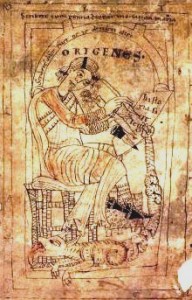Pietists as Pentecostal Forerunners
Being a ‘fanatic,’ of course, is all in the eyes of the beholder.

Origen, an early Christian theologian, was born in either 184 or 185 and died, probably in Tyre, Lebanon, in either 253 or 254). Some of his views, including apokatastasis (the restoration of all things to their primordial condition), were highly controversial among later theologians.
Both Petersens wrote autobiographies in which they document their biblical hermeneutics as well as interpreting dreams and visions.10 They were both Biblicists, which played no small part in their process, but they consistently explain how they come to their understanding through their reading of Scripture and how this is verified through experiential assurance. For example, they both wrote about receiving simultaneous, but independent messages and interpretation. Two instances of this in their writings, and both are times when they make rather large divergences in their beliefs. The first was in 1685 while they are in separate rooms of the house and both were studying Revelation. Schneider calls this their “discovery of chiliasm.” The second simultaneously, independent discovery was in 1694 when they came to believe that eternal damnation only meant “a very long time”. Their views on apocatastasis were influenced by Jane Leade, but it is one that freethinkers of the past have put forward since Origen. …
Petersen, like many Pietists and Puritans of the time was interested in signs of revival in other countries. He was in contact with the Huguenot refugees after the Edict of Nantes in 1685. It was at this time that he came in contact with Jane Leade and the Philadelphians in England, etc. These, along with political events like the “Great War against the Turks” (1683-1699) and the approach of the year 1700, meant that Petersen was part of a large movement that was “scouring the heavens for signs.” Researchers such as Schneider see the concept of Philadelphianism as the most significant for Petersen and the radical Pietists.
The term “Philadelphia” appears again and again in Der Macht der Kinder. It symbolizes their theological and apocalyptical speculations concerning the unfolding of history …
The Silesian Kinderbeten
The “Praying Children” (Kinderbeten) touched off a larger revival which endured in Silesia for decades.15 The children resumed meeting for prayer in various areas at times of renewed trouble until the Prussian invasion of 1740. The Silesian revival spread and had direct influence on other Central European countries,16 especially Moravia and Bohemia. The children’s revival in one of Zinzendorf’s settlements for Moravian refugees two decades later was one of their two formative events,17 and those children had the story of the Silesian Kinderbeten told to them by adults who had experienced it (the Zinzendorf estates bordered Silesia and he had traveled through Silesia to learn more about the Awakening there). There are records of children’s revivals occurring in Europe through the 19th century, and there are, of course, contemporary reports around the world, but the Silesian Kinderbeten seems to have no direct predecessors and a case can be made that it is a more pure form of revival than any examined so far, i.e., it really hadn’t been organized or “gotten up” by any revivalists.
Category: Church History, Pneuma Review, Summer 2012


